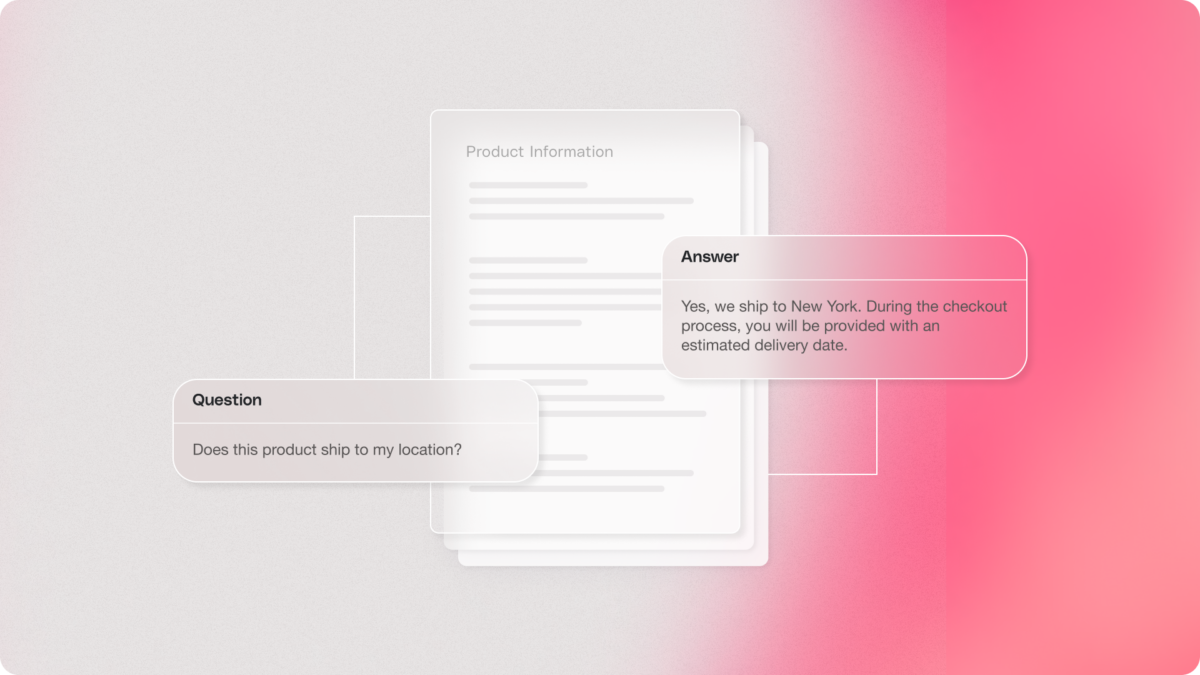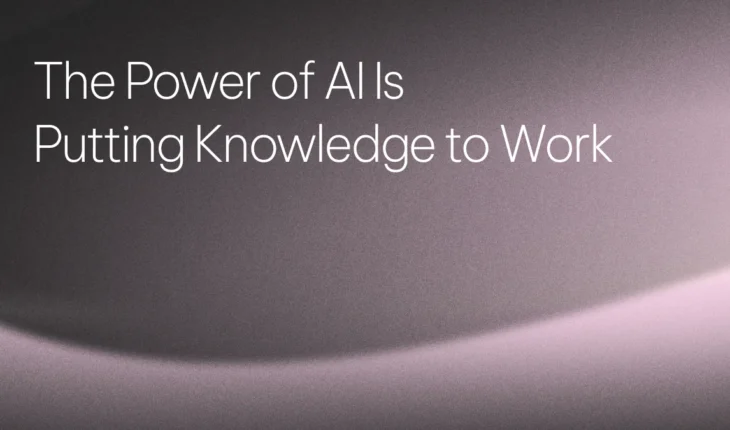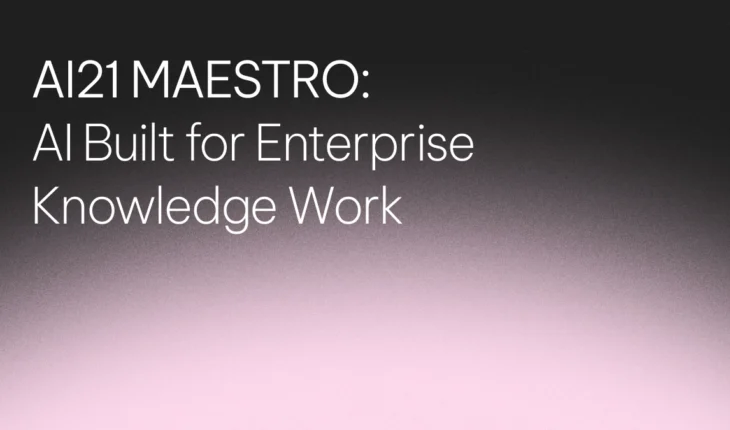Table of Contents

The Promise of RAG: Bringing Enterprise Generative AI to Life
If you’ve been following generative AI and large language models in the past few months, chances are you have also heard the term Retrieval-Augmented Generation or RAG for short. Not just a buzzword, RAG shows incredible promise in overcoming hurdles in large language models (LLMs) that currently prevent adoption for enterprises in production environments.
For LLMs like Jurassic to truly solve a business problem, they need to be attuned to the unique body of knowledge that each organization has. Think of a generative AI-powered chatbot that interacts with retail bank customers. A bot powered by a general knowledge-trained LLM can broadly inform customers what a mortgage is and when it can generally be issued, but this is hardly helpful to a customer who wants to know how a mortgage is applicable to their specific circumstance. On the other hand, a chatbot using RAG understands the context: the bank’s unique mortgage policies, customer banking details, and other proprietary organizational information to provide a tailored, accurate, grounded answer to a customer’s question about a mortgage.
What is Retrieval Augmented Generation (RAG)?

Retrieval Augmented Generation (RAG) integrates the deep understanding and generation capabilities that language models have, with the vast, unique knowledge of each organization. It does this by combining two processes: retrieval and augmented generation. Retrieval involves searching through documents to find relevant information that matches a user’s query or input. Augmented generation then generates text based on the retrieved information, using instruction-following large language models (LLMs) or task-specific models.
Companies across industries are experimenting with implementing RAG into their systems, recognizing its potential to significantly enhance the quality and relevance of generated content by providing up-to-date, factual information drawn from a broad range of sources within the organization. RAG gives organizations the ability to base text generation on information contained in a corpus of text, also known as grounding.
By retrieving relevant context using RAG, companies can realize many benefits in their generative AI solutions, such as:
- Improving factual accuracy & minimizing risk
- Generating more specific and nuanced text
- Allowing for better personalization
Top RAG Use Cases in the Enterprise
RAG use cases in applications can generally be categorized into two main categories: Internal (organizational-facing) applications that are aimed at improving organizational efficiency and knowledge management and External (customer-facing) applications which focus on enhancing customer experience and engagement.
Internal RAG use cases
Internal RAG-based applications target internal stakeholders within an organization, such as employees or managers, helping them navigate and utilize the vast amount of organizational knowledge effectively. Below are just a few examples of use cases we’ve seen our customers adopt.
- Employee productivity apps – Assist employees in finding and leveraging existing organizational knowledge buried across databases, emails, and documents.

- Analysis assistants – Provide insights to employees through document summarization or Q&A by retrieving and synthesizing internal research documentations, such as financial reports, research studies, clinical trials, market trends, competitor analysis, and customer feedback.

- Employee training tools – Help onboard and educate new employees with tools that locate relevant information.
External RAG use cases
External RAG-based applications focus on enhancing the customer experience and engagement, retrieving secured organizational data on behalf of customers or clients.
- Customer support chatbots – Enhance customer support by providing accurate, context-rich responses to customer queries, based on specific user information and organizational documents like help center content & product overviews.

- Public-facing Q&A systems – Address customer inquiries and tickets with accurate and detailed answers grounded in your organization’s proprietary knowledge. For example, implemented in a retail website, such a system would address questions about specific products, shipping policies, and more. An important feature is that the system won’t respond to any questions whose answers aren’t in the associated documents. This is critical for mitigating risk and ensuring compliance especially for privacy-sensitive enterprises.
How Does It Work?
As its name implies, RAG consists of two main steps, retrieval and augmented generation.

Retrieval
Retrieval is the process of searching through organizational documents to find relevant information that matches a user’s query or input. Retrieval techniques range from simple keyword matching to more complex algorithms that analyze document relevance and user context. The effectiveness of a retrieval system is measured by its ability to provide accurate, relevant, and timely information, meeting the precise needs of its users.
Semantic Search
One of the more advanced approaches on the retrieval spectrum is semantic search. Semantic search is the technique of understanding the underlying intent of a search query to retrieve relevant results from a corpus of documents. Beyond simple keyword matching, it matches the semantic meaning with the help of machine learning and AI technologies. For example, semantic search would know to closely match the terms “cute kittens” to “fluffy felines”, even though there is no literal word match.
There are several steps required to build a semantic search system, involving different processes:
- Embedding (vectors): An embedding model transforms text from indexed documents and a query into fixed-size vectors (a list of numbers), capturing their semantic meanings in a high-dimensional space. This allows computers to semantically search for relevant information in a user query.
- Vector Database: Embeddings are typically stored in a dedicated vector database (provided by vendors such as Pinecone or Weaviate), which can search through vectors to find the most similar results for a user query. Vector databases are designed to be highly scalable and efficient when searching through billions of vectors.
- Document chunking: To improve vector search and retrieval, it is recommended to first segment large documents into smaller chunks (around a paragraph each) by topic. This will allow you to create vectors for each chunk, rather than for the entire document, enabling even more fine-grained vector search. It also allows you to locate specific relevant text from your source documents, and pass it to a language model for text generation.
Augmented generation
Once organizational information is retrieved through semantic search, general purpose LLMs like Jurassic can then generate a response according to the prompt it was given (such as “summarize the content”, or “answer an end user question”). Task-specific models such as Contextual Answers, designed for RAG-based Q&A, can also be used out-of-the-box to craft an answer to a question without any prompt engineering needed.
Building a RAG solution is easy. Building a great one is not.
Although retrieval tools and knowledge are widely available, moving from proof of concept (POC) to production for enterprises is harder than it seems. No matter how tech savvy your organization may be, building and maintaining a multi-document retrieval system is complex and comes with many difficulties:
- Optimizing chunking and embedding processes and models in order to achieve high-quality retrieval results
- Supporting various file types (e.g. PDF, DOCX) and correctly extracting information from each file type (e.g. complex tables)
- Creating an effective context based on the retrieved chunks to optimize generation output
- Scalability when indexing and retrieving a large number of documents stored in one or more organizational data sources, common for production workloads. Organizational data can reside in different systems – file management systems (such as Google Drive or OneDrive), file storage (such as S3 or Google Storage), writing platforms (such as Confluence or Notion), customer support systems (such as Intercom or Zendesk) and others. Depending on the use case, organizations will need to create an ingestion pipeline to index documents from one or more systems.
- Keeping synchronization between original documents and indexed documents as content in documents changes over time.
- Adhering to organizational user and group permissions when retrieving documents.
- Legal, security and privacy concerns affecting data location. Building a RAG system must comply with relevant regulations such as GDPR, which may dictate data persistence, the necessity of on-premise or Virtual Private Cloud (VPC) storage, and restrictions on geographical data transfer and storage.
While individual tools for creating retrieval solutions are becoming more accessible and various new retrieval frameworks are emerging, developing a robust semantic search system remains a significant challenge for organizations.
AI21’s RAG Engine (Or, Why Reinvent the Wheel?)
AI21’s RAG Engine offers enterprises an all-in-one solution for implementing Retrieval-Augmented Generation. RAG Engine allows companies to upload their organizational documents, retrieve the most relevant information for a given query, and connect that context to a large language model like Jurassic-2 or a task-specific model to generate text. RAG Engine is conveniently packaged and accessible via an API endpoint.
It also adeptly addresses implementation challenges, offering a RAG solution built for production use cases in the enterprise. It lets you efficiently integrate advanced retrieval capabilities without having to invest heavily in development and maintenance. RAG Engine contains built-in mechanisms for every step of the way, including document extraction, chunking, embeddings, vector storage and retrieval.
We’ve used our experience helping thousands of global enterprises, including leaders in banking, life sciences and retail, to create the optimal retrieval solution. We believe organizations can greatly benefit from out-of-the-box solutions that streamline the process and reduce technical overhead so they can focus on their core business.
- Seamless integration between retrieval and generation – RAG Engine automatically integrates with many of our task-specific models, so you can surface search results or provide a grounded answer to a query based on your organizational data – all within a single API call. You can also connect RAG Engine with a foundation model like Jurassic – and use Semantic Search results within a prompt.
- Built-in data source integration – You can integrate your organization’s data sources, such as Google Drive, Amazon S3, and others, to automatically sync documents with RAG Engine. To enable data source integration, contact us.
- Supports various file formats and data types – Using our document extraction capabilities, ensure high-quality retrieval across file types like PDFs and DOCX files, while adeptly handling complex structures such as tables.
- Builds effective contexts for language models – Our Embeddings and Text Segmentation models use advanced semantic and algorithmic logic to create the optimal context from retrieval results, significantly enhancing the accuracy and relevance of generated text.
- Easy maintenance – RAG Engine maintains synchronization between original and indexed documents as they evolve, ensuring up-to-date information retrieval.
- Secure and appropriate access to documents – Adhere to organizational user and group permissions with a comprehensive approach that addresses the intricate needs of document management in modern, data-intensive environments.
RAG Engine gives enterprises a robust managed retrieval system that integrates production-grade models as key components. However, if you prefer the flexibility to build your own retrieval solution, you can access these task-specific models, optimized to excel in their respective task.
- Semantic Search model – Retrieves the most relevant chunks (segments) from text based on the intent and contextual meaning of a query
- Text Segmentation model – Breaks down text into chunks (segments) with distinct topics using advanced semantic logic
- Embeddings model – Uses advanced techniques to create contextual embeddings, significantly enhancing the accuracy and relevance of search results
- Document Extraction model – Filters and extracts relevant information from large volumes of data, including PDF and DOCX files with complex tables
Looking Ahead
Many enterprises are looking to move beyond LLM experimentation to adoption by implementing RAG-based solutions. RAG holds a lot of promise for overcoming reliability challenges through grounding and deep understanding of a given context. Despite the plethora and availability of knowledge and tools, building a RAG system fit for enterprise production needs is not as simple as it seems. Organizations must build, optimize and continuously maintain numerous processes of the RAG pipeline, including chunking and embedding, in order to produce an optimal context that can be integrated with LLM generation capabilities.
No matter how technologically adept your organization is, building a RAG solution is costly in time and resources. With customers from the top banks, analytics, healthcare and retail companies utilizing our RAG Engine, we can help.



